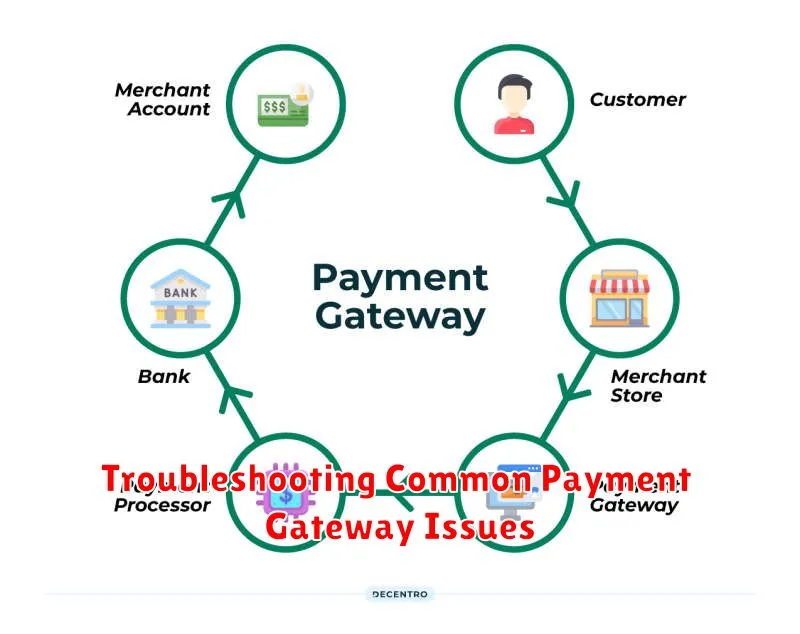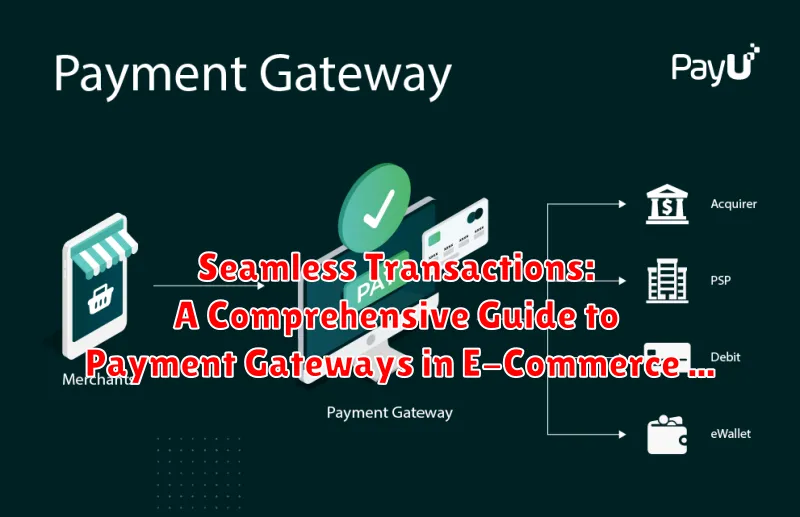In today’s rapidly evolving digital landscape, e-commerce businesses thrive on providing seamless transactions. A key component facilitating these smooth online purchases is the payment gateway. This comprehensive guide delves into the intricacies of payment gateways, exploring their crucial role in enabling secure and efficient online transactions for e-commerce platforms. Understanding the various types of payment gateways, their functionalities, and their impact on the customer experience is essential for any business operating in the e-commerce sphere. This knowledge empowers businesses to optimize their payment processing systems and ultimately drive growth.
From the perspective of both the merchant and the consumer, seamless transactions are paramount in the e-commerce world. This guide offers a detailed examination of the mechanisms behind payment gateways, outlining how they securely process transactions, manage sensitive financial information, and integrate with various e-commerce platforms. We will explore the different payment gateway options available, including hosted, integrated, and direct payment gateways, comparing their features, benefits, and drawbacks to help businesses make informed decisions for their specific e-commerce needs. By understanding the nuances of payment gateways, businesses can enhance the customer journey, minimize friction during the checkout process, and foster trust and loyalty, ultimately driving conversions and maximizing revenue within their e-commerce operations.
Understanding the Role of Payment Gateways in Online Sales
In the realm of e-commerce, payment gateways play a critical role in facilitating seamless and secure transactions. They act as the bridge between your online store and the payment processor, enabling customers to make purchases smoothly and efficiently.
Think of a payment gateway as the digital equivalent of a physical point-of-sale terminal in a brick-and-mortar store. When a customer completes their online purchase, the payment gateway securely transmits their payment information to the payment processor for authorization and settlement.
This process ensures that funds are transferred securely from the customer’s account to the merchant’s account, allowing businesses to accept various payment methods like credit cards, debit cards, and sometimes even alternative payment options. Without a payment gateway, accepting online payments would be a complex and highly insecure process.
By leveraging a payment gateway, businesses can streamline their sales process, reduce the risk of fraud, and enhance the overall customer experience, ultimately contributing to increased sales and business growth.
How Payment Gateways Work: A Step-by-Step Guide
A payment gateway acts as a bridge between your online store and the payment processor, facilitating secure and efficient transactions. Here’s a breakdown of the process:
-
Customer Initiates Payment: The customer selects their desired products and proceeds to checkout.
-
Payment Information Submission: The customer enters their payment details (credit card number, expiry date, CVV, etc.) on your secure checkout page.
-
Encryption and Transmission: The payment gateway encrypts the sensitive data and transmits it securely to the payment processor.
-
Authorization Request: The payment processor communicates with the customer’s issuing bank to request authorization for the transaction.
-
Authorization Response: The issuing bank either approves or declines the transaction based on the customer’s available funds and account status.
-
Transaction Completion: The payment gateway relays the authorization response back to your online store. If approved, the transaction is completed, and you receive payment. If declined, the customer is notified.
This entire process typically happens within seconds, ensuring a seamless checkout experience for your customers.
Types of Payment Gateways Available for E-Commerce
E-commerce businesses can choose from various payment gateway types, each offering unique features and functionalities. Understanding these distinctions is crucial for selecting the optimal solution for your specific needs.
Hosted Payment Gateways redirect customers to a third-party page to complete their transaction. This simplifies PCI compliance for merchants but can result in a less seamless customer experience.
Self-Hosted Payment Gateways allow customers to enter their payment information directly on your website, providing a more integrated checkout process. However, this requires stricter adherence to PCI DSS standards.
API Hosted Payment Gateways offer a balance between the two, allowing you to customize the look and feel of the checkout process while leveraging the gateway’s secure infrastructure for processing payments.
Local Bank Integrators are popular in some regions, directly connecting your website to a local bank’s payment processing system. This can simplify transactions for customers familiar with those banks.
Key Features to Look for in a Payment Gateway
Selecting the right payment gateway is crucial for a smooth and secure checkout experience. Several key features should be considered when evaluating different providers.
Security is paramount. Look for features like PCI DSS compliance, fraud detection tools, and tokenization to protect sensitive customer data.
Supported Payment Methods should align with your target audience. Ensure the gateway supports major credit and debit cards, as well as alternative payment options like digital wallets or mobile payments if relevant to your customer base.
Transaction Fees and processing costs vary between providers. Carefully evaluate pricing structures, including transaction fees, monthly fees, and any setup costs, to determine the most cost-effective option for your business.
Integration with your existing e-commerce platform is essential for a streamlined setup process. Check for compatibility and available plugins to simplify integration.
Customer Support is vital for troubleshooting any technical issues or addressing customer inquiries. Look for a provider with responsive and readily available support channels.
Choosing the Right Payment Gateway for Your Business
Selecting the right payment gateway is crucial for a smooth and secure checkout experience. Several factors influence this decision, making it essential to carefully evaluate your business needs.
Transaction volume is a primary consideration. High-volume businesses benefit from gateways offering lower per-transaction fees. Conversely, low-volume businesses might find gateways with higher per-transaction fees but lower monthly fees more economical.
Business location and target market also play a role. Ensure the gateway supports currencies and payment methods prevalent in your target regions. Consider the security features offered by the gateway, such as fraud prevention tools and PCI DSS compliance.
Finally, evaluate the integration process. Choose a gateway that seamlessly integrates with your existing e-commerce platform and other business tools.
Integrating Payment Gateways into Your E-Commerce Platform
Integrating a payment gateway is crucial for accepting online payments. The process generally involves selecting a provider and then technically integrating it with your platform.
Choosing a payment gateway requires careful consideration of factors such as transaction fees, supported currencies, and security features. Popular gateways include Stripe, PayPal, and Square. Each offers different features and pricing structures.
Technical integration typically involves using APIs or SDKs provided by the gateway. Your e-commerce platform may have built-in integrations or require custom development. This step connects your website’s checkout process to the payment gateway, allowing customers to securely enter their payment information.
Testing the integration is essential before going live. This ensures that transactions are processed correctly and that customer data is handled securely. Thorough testing minimizes potential issues and ensures a smooth customer experience.
Security Considerations for Payment Gateways and Online Transactions
Security is paramount when dealing with online transactions. Choosing a secure payment gateway is the first crucial step. Look for gateways that comply with PCI DSS (Payment Card Industry Data Security Standard). This standard ensures the gateway adheres to strict security protocols for handling sensitive cardholder data.
SSL encryption is essential for securing the communication channel between the customer’s browser and your website. This encryption prevents eavesdropping and data theft during the transaction process. Ensure your website has a valid SSL certificate.
Implementing two-factor authentication (2FA) adds an extra layer of security for both you and your customers. 2FA requires users to provide two forms of identification before accessing an account, reducing the risk of unauthorized access.
Regularly monitoring transactions for suspicious activity is key to preventing fraud. Implement systems that can flag unusual transaction patterns, such as large purchases or transactions from unfamiliar locations. Promptly investigate any red flags.
Best Practices for Secure Online Payments

Implementing robust security measures is crucial for protecting both businesses and customers from online fraud. Adhering to best practices significantly reduces risks and builds customer trust.
Use strong passwords and multi-factor authentication (MFA). MFA adds an extra layer of security, making it significantly harder for unauthorized access even if passwords are compromised.
Regularly update software and security patches. Keeping your e-commerce platform and payment gateway software up-to-date ensures you have the latest security protections against known vulnerabilities.
Educate customers about secure online practices. Encourage customers to use strong passwords, avoid public Wi-Fi for transactions, and regularly monitor their bank statements for suspicious activity.
Comply with PCI DSS standards. The Payment Card Industry Data Security Standard (PCI DSS) provides a framework for securing cardholder data, minimizing the risk of data breaches.
Monitor transactions for suspicious activity. Implement fraud detection tools and regularly review transactions for any unusual patterns or discrepancies that may indicate fraudulent activity.
Troubleshooting Common Payment Gateway Issues

Encountering payment gateway issues can be frustrating for both businesses and customers. Here’s a guide to troubleshooting some common problems.
Transaction Declines
Declined transactions are often due to insufficient funds, incorrect card details, or security flags. Advise customers to verify their information and contact their bank if the issue persists. Merchants should also check for any issues on their end, such as incorrect gateway configuration.
Authorization Failures
Authorization failures can stem from issues with the customer’s bank, the payment gateway, or the merchant’s account. Check for connectivity problems, gateway downtime, or any processing errors reported by the gateway.
AVS Mismatches
Address Verification System (AVS) mismatches occur when the billing address provided by the customer doesn’t match the address on file with their card issuer. This is a security measure to prevent fraud. Advise customers to double-check their entered address.
CVV Errors
Card Verification Value (CVV) errors arise when the CVV code entered doesn’t match the one on the card. This can indicate a typo or potential fraud. Ask customers to carefully re-enter the CVV.
The Future of Payment Gateways in the Digital Age
The future of payment gateways is poised for transformative change, driven by evolving consumer behavior and technological advancements. Invisible payments are becoming increasingly prevalent, seamlessly integrating into the customer journey. Think one-click purchasing and biometric authentication, minimizing friction at checkout.
Cryptocurrency and blockchain technology are likely to play a larger role, potentially offering faster and more secure transactions while reducing transaction fees. The rise of decentralized finance (DeFi) may further disrupt traditional payment systems.
Artificial intelligence (AI) and machine learning will enhance fraud detection and prevention capabilities, strengthening security for both merchants and consumers. These technologies can analyze vast datasets to identify and prevent fraudulent activities in real-time.
The continued growth of mobile commerce necessitates payment gateway solutions optimized for mobile devices. Expect to see further development of mobile wallets and in-app payment options.

